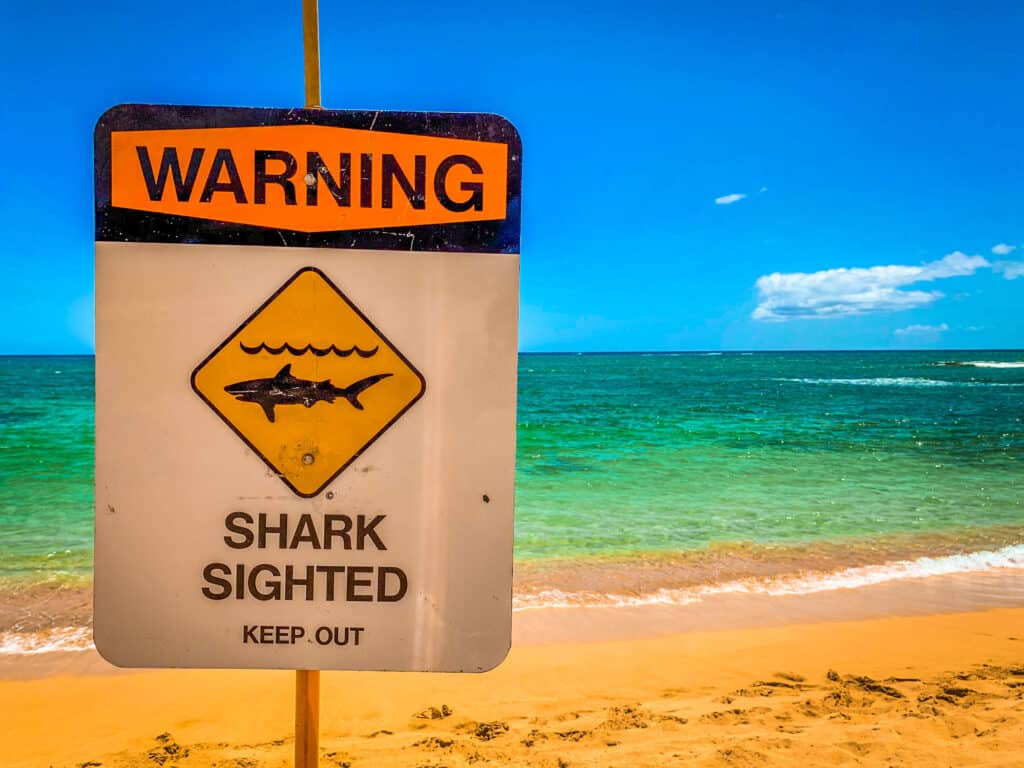Ever been swimming in the ocean, and found yourself wondering if any sharks are close by? Are news reports of shark bites at certain beaches triggering your fin-phobia? Well, you probably don’t want to hear that according to new research, it turns out that sharks do get much closer to us than most of us realize. Uh-oh! But before you turn in your beach tag, keep reading. Because in terms of shark attack risk, this is actually good news.
Shark Attack: What are the Odds?

Mind if I join you? New research shows that sharks get uncomfortably close.
©iStock.com/Alessandro De Maddalena
Statistically speaking, the average person’s likelihood of getting bitten by a shark is quite low. According to the Florida Museum of Natural History’s International Shark Attack File, the odds of dying in a shark-related fatality are 1 in 4,332,817. That’s rarer than being killed by lightning (1 in 79,746) or in a car crash (1 in 84). In terms of beach danger, the odds of drowning are 1 in 3.5 million, while the odds of a shark attack—fatal or non-fatal—are 1 in 11.5 million.
In recent years, the number of unprovoked shark bites worldwide has been in decline, possibly due to a combination of stricter beach safety protocols (good) and fewer sharks in the world’s oceans (bad). The yearly average since 2013 has been 74 unprovoked bites worldwide; in 2022 the number was 57. However, certain spots have seen a surge in reports of unprovoked bites. The beaches of New York had a record of eight bites in 2022, and by July 2023 four shark bites were reported. This may be due to shifts in the Gulf Stream bringing fish, and sharks preying on them, closer to shore. Juvenile sharks, in particular, are more prone to confuse a swimmer for their intended prey.
How Close Do Sharks Get to Us?
Are you in the ocean right now? I mean, hopefully not, because the salt water’s not good for your screen. Maybe you’re on a boat? Anyway, when you’re swimming in the ocean it’s possible a shark could be right next to you and you’d never know it. That’s the message of a study done by researchers from the Shark Lab of California State University, Long Beach. They used drones to observe the waters of 26 Southern California beaches over the course of two years.
They found that in places where juvenile white sharks (aka great white sharks) congregated. Most of the time — that is, on 97% of the days when the drone observations were done — juvenile great whites were seen swimming in close proximity to people. Waders, who kept between the shore and the wave break zone (where waves start to crest), didn’t share space with sharks, but swimmers, surfers, and stand-up paddlers did.
The researchers defined “close proximity” as within 100 meters, about the length of a football field. Though the study did not describe the shortest shark-to-human interval, in press interviews the researchers have noted that sharks can swim “right by” a surfer or swimmer without the person knowing it. Drone video footage from the study shows sharks coming — well, let’s say uncomfortably close.
Should This Scare Me? Because I’m Pretty Scared TBH.
We should keep in mind that the study included spots where these sharks are known to congregate. Outside of those areas, no sharks were observed in proximity to human beings. More significantly, where sharks and humans were swimming together, no incidents of shark aggression or unprovoked shark attacks occurred. Shark attack risk in the areas studied, and in general, is very low. So an important takeaway from this research is that being near a shark doesn’t translate to a higher risk of attack. Sharks don’t see humans as prey. They’re just not that into us.
Improving the (Already Pretty Good) Odds

Pay attention to updates about shark activity where you swim.
©iStock.com/Five Buck Photos
Rare as they are, unprovoked shark attacks do occur, and it’s not always clear why. Some shark species seem more prone to attacking humans than others. Keep these precautions in mind to coexist safely with sharks, as near as they may be.
- Don’t swim alone. Sharks are more likely to approach a lone swimmer or surfer.
- Stick close to shore. In the study, the sharks were only present past the wave break zone.
- Avoid steep ocean floor drop-offs or areas between sandbars. Sharks favor these spots since that’s where their prey hangs out. Avoid murky water; sharks may have a hard time seeing that you’re not their prey.
- Don’t swim near places where people are fishing. Stay away from spots where seabirds are active; that could mean fish, and the sharks hunting them, are near.
- Don’t swim at dawn or dusk, or at night, which is when many sharks are most active.
- Avoid wearing shiny jewelry or anything reflective.
- Swim only at posted, guarded beaches. Pay attention to local warnings about shark activity.
The photo featured at the top of this post is © Willyam Bradberry/Shutterstock.com
Thank you for reading! Have some feedback for us? Contact the AZ Animals editorial team.







